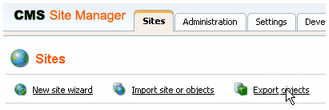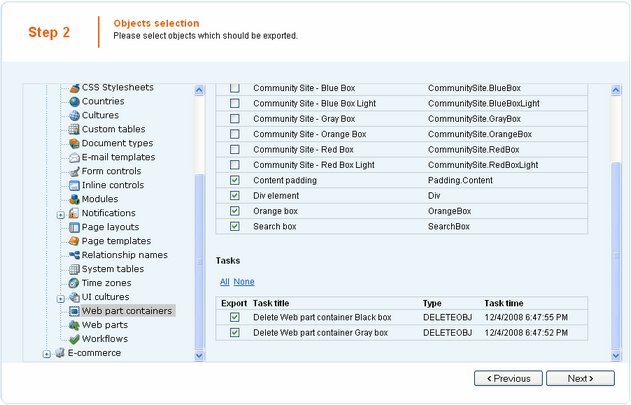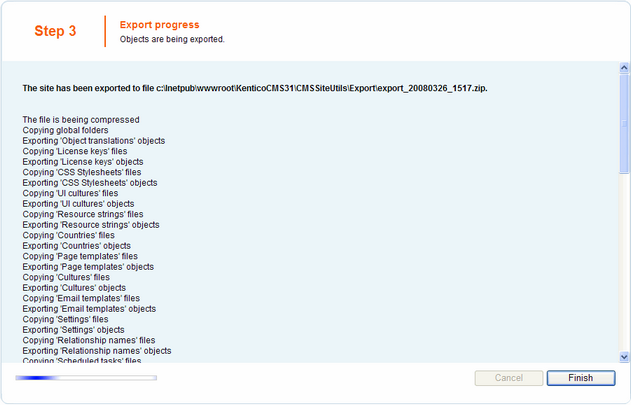Besides exporting the whole web site, you can also choose to export only selected objects (web parts, document types, page templates, etc.). This is useful when you update some object on the development machine and want to copy the updated object to the staging or production server.
Exporting selected objects
Go to Site Manager -> Sites and click Export objects. The Export objects wizard starts.

In the first step of the wizard, you have to fill in the name of the export package and choose type of objects pre-selection:
| • | File name - name of the export package; a default name will be pre-filled and the package will be stored in <web project>\CMSSiteUtils\Export. |
| • | Do not preselect any objects - no objects will be preselected in the next step |
| • | Preselect all objects - all objects will be preselected in the next step |
| • | Preselect objects changed after specific date - only objects changed after the specified date will be preselected in the next step |
| • | Use previous export settings - settings used in a previous export selected from the list below will be used |
Select the option that suits your purposes and click the Next button.

In Step 2, you can select which objects will be exported. The tree on the left represents object categories. These reflect the sections of the administration interface under that the objects can be found. The Site category contains objects related to the selected web site. The Global objects category contains global objects that can be used by all sites. By selecting a category, a set of check boxes appears in the right part of the screen, letting you select which objects will be exported. If you select the root of the tree (All objects), you will be offered with the following options:
Global selection
| • | Load default selection - objects will be selected based on the pre-selection choice made in Step 1 |
| • | Select all objects - all objects will be selected |
| • | Deselect all objects - no objects will be selected |
Export settings
| • | Export files - some objects in the database are linked with physical files in the file system; if you check this check-box, these files will be exported along with the database objects |
| • | Export global folders - if checked, global files under the folders listed below will be exported |
- <web project>\App_Code\Global
- <web project>\CMSGlobalFiles
| • | Export ASPX templates folder - if checked, folder with ASPX page templates will be exported |
- <web project>\CMSTemplates
| • | Export forum custom layouts folder - if checked, folder with custom forum layouts will be exported |
- <web project>\CMSModules\Forums\Controls\Layouts\Custom
| • | Export tasks - if checked, delete tasks (incremental deployment) will be included in the package |

If you have the "Log export tasks" option enabled in Site Manager -> Settings -> Content Staging, a list of object deletion tasks may also be displayed at the bottom of the list. This happens when some objects have been deleted (just as the two Web part containers in the screenshot below). If you leave the check-boxes checked, the objects will be deleted after importing the package on the target server.

After making all required selections, click Next to proceed to the next step.
A log appears, showing you the progress of exporting. You can abort exporting by clicking the Cancel button at any time. When exporting finishes, a message appears at the top of the log, telling you the full path to the exported file. Click the Finish button. You will be redirected back to Site manager -> Sites.

Now you can copy the exported file to the target installation of Kentico CMS, into the <web project>\CMSSiteUtils\Import folder and use the Import site or objects wizard described in the following chapter.